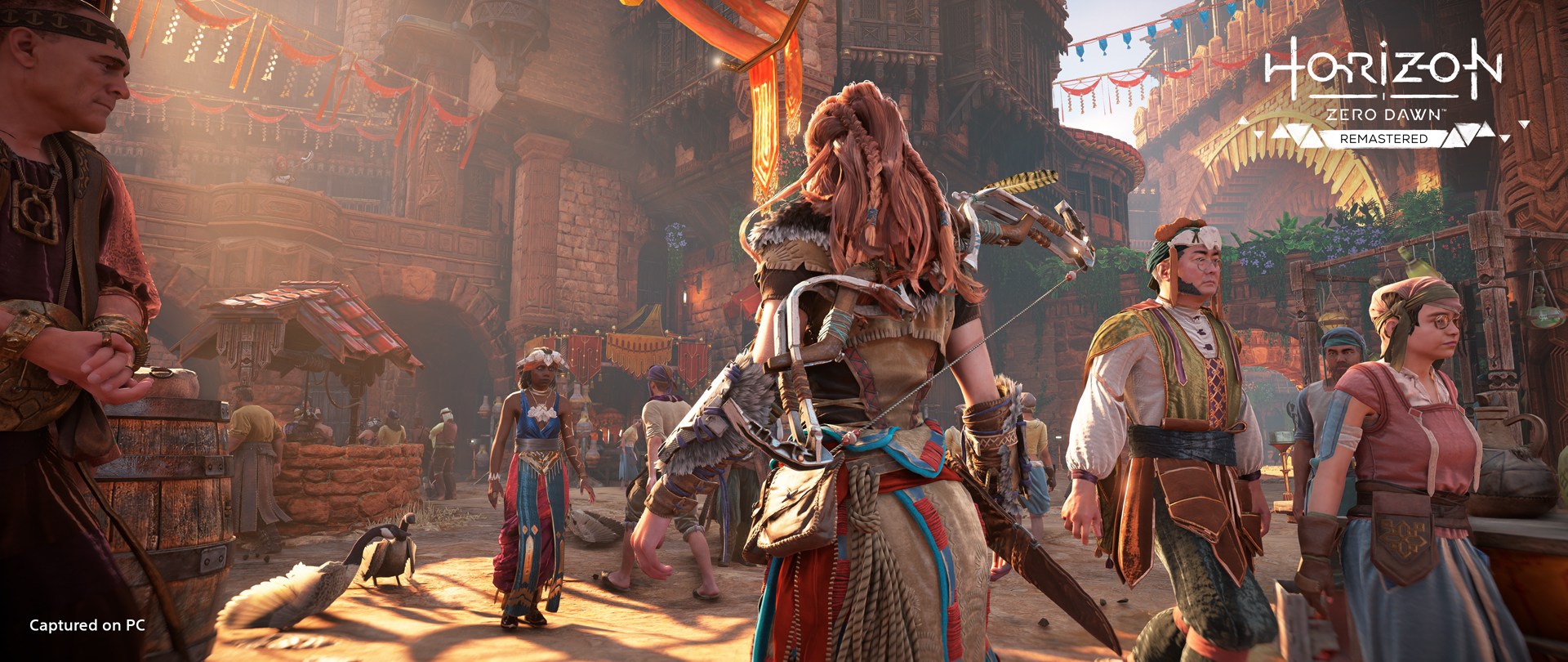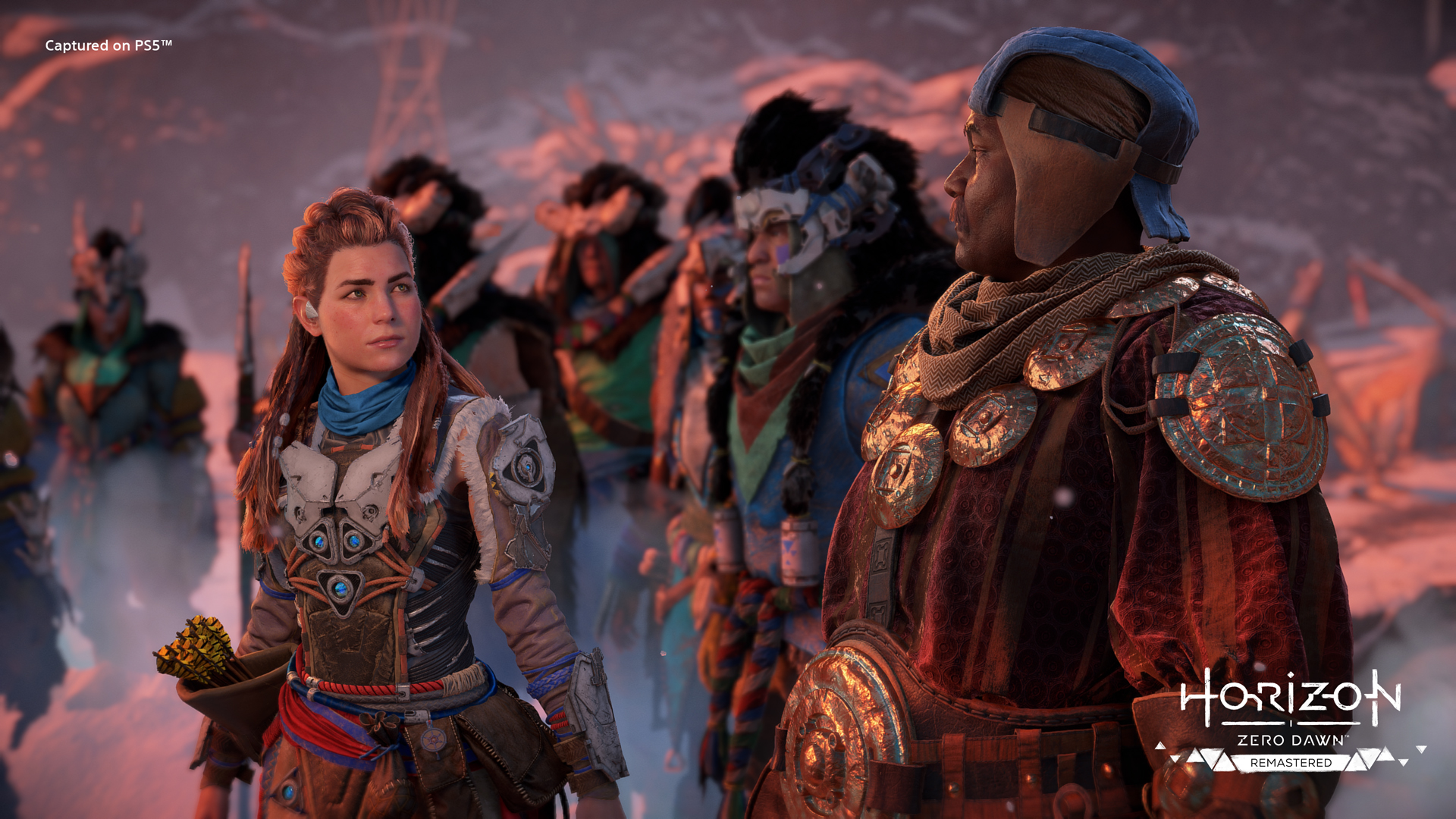Overhauling nature
Foliage plays a big role in portraying the lush, overgrown ruins of a long-lost civilization in the world of Horizon. Our team of Environment Artists considered the foliage in Horizon Zero Dawn to be an industry standard, and Horizon Forbidden West added to that with significant improvements in visual quality. For the remaster, the team wanted to give the foliage the same care and attention.
Patrick Blankenzee, Senior Environment Artist:
“To bring the foliage in the remaster up to the same level of quality as in Horizon Forbidden West, we enhanced the shaders, textures, geometry and foliage interaction. We assessed all the foliage assets in Horizon Zero Dawn and upgraded them with all these new features. We did this for hundreds of plants, bushes, flowers and trees.”
“We looked at the biomes in the original game and compared them to the concept art. We found places that we could enhance and bring closer to the original intent, with the rainforest biome being a good example of this. With powerful procedural technology, we injected new foliage and raised the quality and density to new heights. The riverbanks have also been upgraded with more biodiversity to bring them closer to the original intention as seen in the concept art.”

Julian Hofman, Environment Artist:
“Working with the original team over at Guerrilla, we were able to ask questions,and directly compare their latest work on Horizon Forbidden West to the work we were doing for the remaster. This gave us some very specific goals to work towards, like the fresh generation of moss that you can now see Horizon Zero Dawn Remastered.”
“For me, the foliage changes make the game feel more alive and make it live up to the incredibly high standards of the Horizon games. The result is a coherent world to replay or experience for the first time.”

Enhancing the living world
The Design team at Nixxes made several key improvements to Horizon Zero Dawn Remastered. One of the most significant changes is the enhancement of the living world.
Brian van Nunen, Senior Technical Game Designer:
“To achieve this, we reviewed all villages, outposts and cities, identifying areas that felt empty or where we could improve realism and immersion.”
“Building the game for PS5 allowed us to leverage the increased amount of memory available, enabling us to significantly boost the number of non-player characters. We added many more places for NPCs to stand, sit, work and fulfil their needs. We gave them more varied schedules to increase movement and liveliness in different areas. We also tried to make creative use of existing animations. For example, there is now a woman feeding geese at the well in Meridian, reusing an existing sowing animation. Additionally, on the bridge to Meridian, we’ve made significant strides in improving the atmosphere and sense of activity.”

Improving terrain and building blocks
Our Tech Art team used the library of next-gen materials that were created for Horizon Forbidden West to enhance the quality of assets used for terrain, objects and buildings significantly in the remaster.
Sander Bronkhorst, Senior Technical Artist:
“We began by replacing all the Horizon Zero Dawn terrain materials with their new Horizon Forbidden West counterparts. This was only the first step, as the sequel’s terrain materials didn’t always align with the original aesthetics. To address this, we carefully tweaked and polished each individual terrain material to closely match the look and feel of the original game, while maintaining the visual fidelity of the terrain materials in Horizon Forbidden West.”

 “In addition to updating all the terrain textures and materials, we incorporated features like deformable snow and sand. Snow deformation was first introduced in the Frozen Wilds expansion, but in the remaster, you will find this feature outside that area as well.”
“In addition to updating all the terrain textures and materials, we incorporated features like deformable snow and sand. Snow deformation was first introduced in the Frozen Wilds expansion, but in the remaster, you will find this feature outside that area as well.”
“In settlements like Meridian and Daytower, the ground required a more unique aesthetic. Previously, Guerrilla used custom meshes and materials for the floors in these settlements, exclusive to these locations. For the remaster, we initially followed this approach, exploring the possibility of increasing texture resolution and adding parallax mapping to areas such as brick floors. However, after initial tests we concluded that in these specific cases this wasn’t going to give us the visual quality that we were aiming to achieve. Therefore, we decided to completely remake the floors in Meridian and Daytower from scratch. This involved creating new high-resolution textures, setting up new materials, painting blend maps, and creating new high-resolution geometry supporting the shapes from the textures used in the material.”
 “Another aspect of the upgrades to the game environment in the remaster are Building Blocks. To give a bit of context here: Building Blocks are the individual assets that are used for set dressing the world of Horizon Zero Dawn. Think of objects like rocks, plants, utensils and even buildings.”
“Another aspect of the upgrades to the game environment in the remaster are Building Blocks. To give a bit of context here: Building Blocks are the individual assets that are used for set dressing the world of Horizon Zero Dawn. Think of objects like rocks, plants, utensils and even buildings.”
“Building Blocks can be divided into two categories: natural and man-made. For both types, we increased the resolution of the textures and adjusted the level of detail (LOD) ranges to ensure higher mesh fidelity.”
“We performed a separate pass on all the man-made Building Blocks, creating new high-resolution geometry for assets that would benefit from this. We found that buildings greatly benefited from having more detailed geometry, as most were using brick-like textures on the walls without the shape of the bricks being reflected in the geometry.”
“To address this, we developed custom tools for generating more detailed geometry for these buildings. The artists used these tools to create new geometry, then manually tweaked and adjusted each individual building for the best visual result.”









 I think Kingdom Come Deliverance 2 will be good.
I think Kingdom Come Deliverance 2 will be good. Once that was done we went to ole boy and jumped em
Once that was done we went to ole boy and jumped em

















